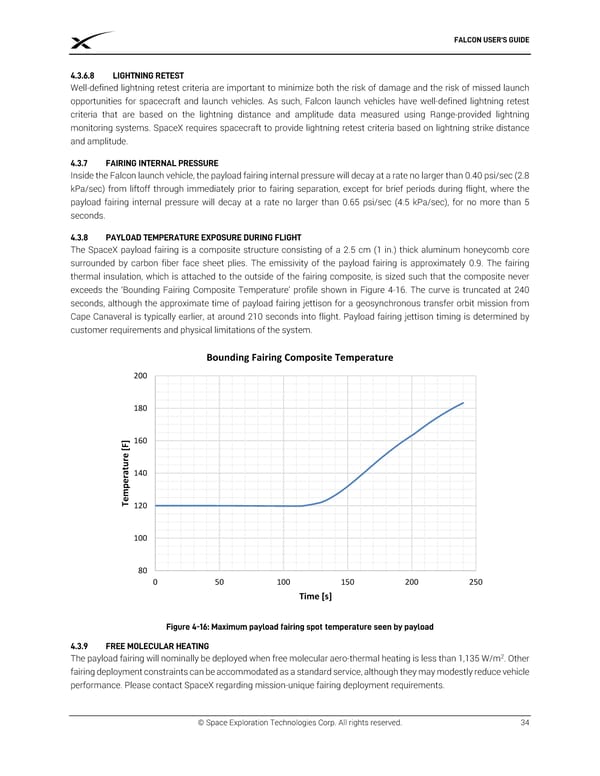FALCON USER’S GUIDE 4.3.6.8 LIGHTNING RETEST Well-defined lightning retest criteria are important to minimize both the risk of damage and the risk of missed launch opportunities for spacecraft and launch vehicles. As such, Falcon launch vehicles have well-defined lightning retest criteria that are based on the lightning distance and amplitude data measured using Range-provided lightning monitoring systems. SpaceX requires spacecraft to provide lightning retest criteria based on lightning strike distance and amplitude. 4.3.7 FAIRING INTERNAL PRESSURE Inside the Falcon launch vehicle, the payload fairing internal pressure will decay at a rate no larger than 0.40 psi/sec (2.8 kPa/sec) from liftoff through immediately prior to fairing separation, except for brief periods during flight, where the payload fairing internal pressure will decay at a rate no larger than 0.65 psi/sec (4.5 kPa/sec), for no more than 5 seconds. 4.3.8 PAYLOAD TEMPERATURE EXPOSURE DURING FLIGHT The SpaceX payload fairing is a composite structure consisting of a 2.5 cm (1 in.) thick aluminum honeycomb core surrounded by carbon fiber face sheet plies. The emissivity of the payload fairing is approximately 0.9. The fairing thermal insulation, which is attached to the outside of the fairing composite, is sized such that the composite never exceeds the ‘Bounding Fairing Composite Temperature’ profile shown in Figure 4-16. The curve is truncated at 240 seconds, although the approximate time of payload fairing jettison for a geosynchronous transfer orbit mission from Cape Canaveral is typically earlier, at around 210 seconds into flight. Payload fairing jettison timing is determined by customer requirements and physical limitations of the system. Bounding Fairing Composite Temperature 200 180 F]160 [ e ur t a 140 r pe m Te120 100 80 0 50 100 150 200 250 Time [s] Figure 4-16: Maximum payload fairing spot temperature seen by payload 4.3.9 FREE MOLECULAR HEATING 2 The payload fairing will nominally be deployed when free molecular aero-thermal heating is less than 1,135 W/m . Other fairing deployment constraints can be accommodated as a standard service, although they may modestly reduce vehicle performance. Please contact SpaceX regarding mission-unique fairing deployment requirements. © Space Exploration Technologies Corp. All rights reserved. 34
 SPACEX FALCON USER’S GUIDE Page 37 Page 39
SPACEX FALCON USER’S GUIDE Page 37 Page 39